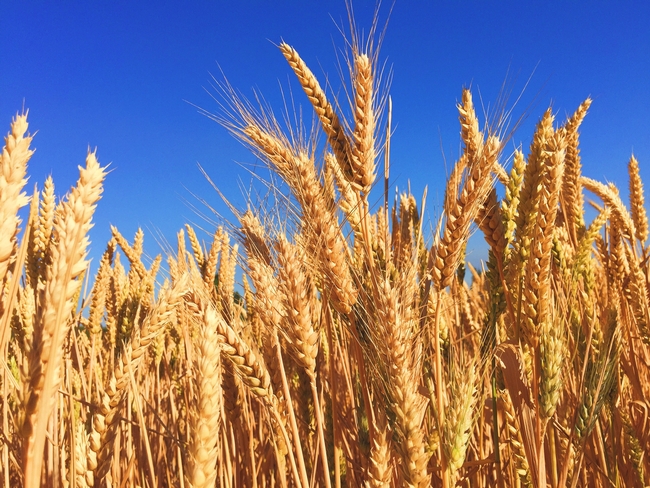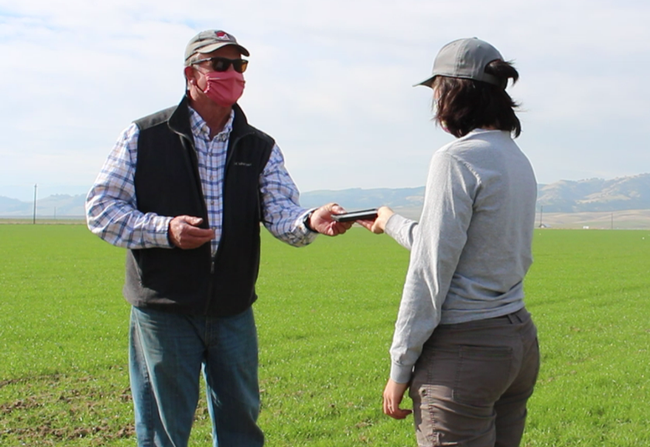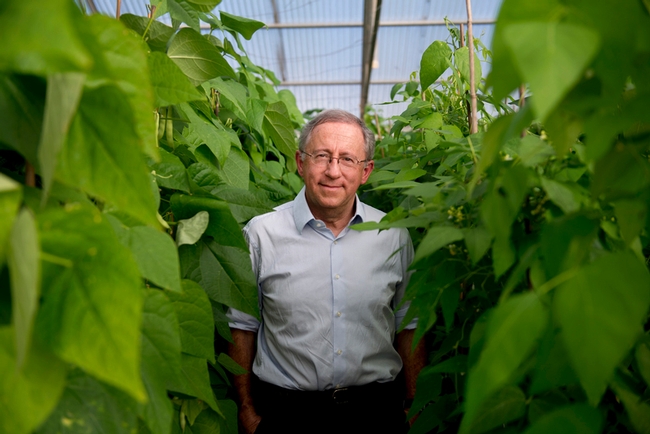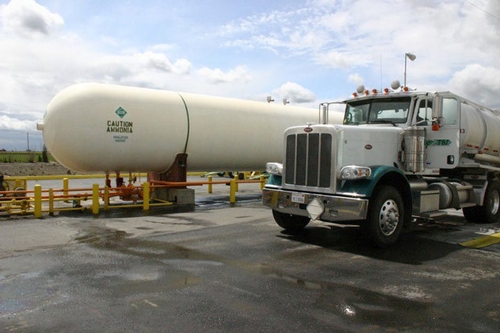Posts Tagged: nitrogen
New ‘big data’ tools help California wheat farmers reduce fertilizer guesswork
Growers in California grapple with plenty of climate uncertainty – but a new set of tools can help wheat farmers make crucial fertilizer decisions with more precision and confidence.
An interactive website integrates these tools – developed or adapted by researchers at the University of California, Davis and University of California Cooperative Extension – that provide farmers with recommendations for applying nitrogen fertilizers, specific to their own sites and conditions.
While factoring in those weather variables, the management tool also draws data from two indicators of nitrogen sufficiency or deficiency: the results of a soil nitrate quick test (a simple test previously used in vegetable crop systems along the coast), and comparisons of plant health in the broader field to that in a “nitrogen-rich reference zone” (a practice originally developed in the Midwest).
Using them in tandem, in the context of California wheat growing, is a novel approach. In a Nov. 4 webinar, Lundy will introduce the use of the nitrogen-rich reference zone, a small area in a field where extra fertilizer is added at the beginning of the season.
“This project is a unique example of digital agriculture at work in an applied setting,” he explained. “We are integrating ‘big data' sources like site-specific soil and weather data, as well as satellite, drone and other sensor measurements into an interactive web interface. This allows users to receive straightforward yet highly customized recommendations from somewhat complex agronomic models.”
The team conducted 11 on-farm demonstrations in fields representing a wide range of agroecosystems, including the Sacramento Valley, San Joaquin Valley, Delta region, and Tulelake Basin.
Fritz Durst, a western Yolo County-based grower who participated in one of the case studies, said that the process of gathering the data was “actually pretty simple” and the tool “eliminates much of the guesswork” for managing nitrogen fertilizers.
“This tool is extremely helpful for me to make decisions about the most efficient and cost-effective method for applying nitrogen to my wheat,” Durst said.
In addition to potentially increasing crop productivity and farmer net-income, the tool can benefit the environment by reducing the amount of nitrate leaching from fertilizer applications, according to Lundy.
“It's not only trying to say how much fertilizer to put down, sometimes it's trying to confirm you don't really need any fertilizer,” he said.
More resources and events related to the Nitrogen Fertilizer Management Tool for California Wheat – including demonstration activities – will appear on the UC Small Grains blog.
Nothing common about these beans
As you're ladling up country-style pinto beans for your weekend barbecue or fixing a cold three-bean salad from kidney, string and navy beans for a summer picnic, pause to remember what a long and storied history these “common bean” varieties share and the new scientific advances that promise to boost their productivity worldwide.
This week, a new genome sequencing is being reported for the common bean, which ranks as the world's 10th most widely grown food crop and includes the culinary favorites above, whose varieties together comprise a $1.2 billion crop in the United States.
“The availability of this new whole-genome sequence for beans is already paying off,” said Paul Gepts, professor in the Department of Plant Sciences at UC Davis and co-author of the new sequencing study.
Gepts, who leads the bean-breeding program at UC Davis, notes that the new sequence is being used to confirm many of the findings made earlier by his UC Davis research group, including identification of the common bean's two points of origin and domestication.
Sequencing and bean ancestry
The common bean is thought to have originated in Mexico more than 100,000 years ago, but -- as the Gepts group earlier discovered – was domesticated separately at two different geographic locations in Mesoamerica and the southern Andes.
“This finding makes the common bean an unusually interesting experimental system because the domestication process has been replicated in this crop,” Gepts said.
The sequencing team compared gene sequences from pooled populations of plants representing these two regions and found that only a small fraction of the genes are shared between common bean species from the two locations. This supports the earlier finding that the common bean was domesticated in two separate events -- one at each location -- but distinct genes were involved in each event.
The new whole-genome sequencing is also helping to identify genetic “markers” that can be used to speed up breeding of new and more productive bean varieties in the United States, East Africa and elsewhere, Gepts said.
The nitrogen connection
All of bean varieties that belong to the “common bean” group share with the closely related soybean the highly valued ability to form symbiotic relationships with “nitrogen-fixing” bacteria in the soil.
The plants and the bacteria work together to convert nitrogen in the atmosphere into ammonia – which includes nitrogen in a form that enriches the soil and feeds crops. Nitrogen-fixing crop plants can actually reduce or eliminate the need for farmers to apply expensive fertilizers.
One goal of the new sequencing project was to better understand the genetic basis for how such symbiotic relationships between nitrogen-fixing plants and bacteria are formed and sustained, with an eye toward increasing fuel- and food-crop productivity.
The research team successfully identified a handful of genes involved with moving nitrogen around, which could be helpful to farmers who intercrop beans with other crops that don't fix nitrogen.
Findings from this study are reported this week online in the journal Nature Genetics. The sequencing project was led by researchers at the University of Georgia, U.S. Department of Energy Joint Genome Institute, Hudson Alpha Institute for Biotechnology and North Dakota State University.
What makes food grow - and why that matters
There’s a lot of attention paid to where food comes from nowadays. Less attention has been paid to what helps that food grow, but that’s an important part of the equation. Whether organic or conventionally grown, the tomatoes, lettuce, plums and other food we eat rely on nutrients in order to grow. One of the most important nutrients for plant productivity is nitrogen.
Nitrogen, which is ubiquitous in our atmosphere in a relatively inert, gaseous form, is not available to most plants unless it is transformed into a reactive form and added to soil, where plants can use it to grow. Most often nitrogen is applied to fields in the form of synthetic fertilizer, although organic production relies on other nitrogen sources, such as cover crops, manure, fish meal and poultry waste.
Agricultural production depends on nitrogen in order to grow reliable, high yielding crops. But this nitrogen, when it is applied to fields in the reactive form that plants can use, also tends to leak out into air and water and cause pollution when all the nitrogen applied to the field is not used up by the plants.
The California Nitrogen Assessment, a project of the Agricultural Sustainability Institute at UC Davis, is taking a hard look at the whole system of nitrogen use in California. While nitrogen is hugely important to producing the food and fiber that we all need, there may be ways to use it more efficiently and reduce the pollution problems it can cause. These problems include air and water pollution, which can have negative consequences for human and environmental health in California.
Since nitrogen is so important to producing the food that all of us eat, the Agricultural Sustainability Institute’s team has involved stakeholders from all around the agricultural system. The assessment team has sought insight from farmers and economists, policy makers and public health groups, and Californians whose drinking water has been polluted by nitrogen, forcing them to buy bottled water on a regular basis. There are many diverse perspectives and ideas about how nitrogen should be managed in California’s future. The assessment will provide a synthesis of the most up-to-date scientific knowledge on science, policy and practice to inform decision making on how to improve nitrogen management.
Thinking about where food comes from is one important part of understanding the food system. Learning about the trade-offs involved in other key agricultural inputs is another.
Find out more about nitrogen and the California Nitrogen Assessment at its website. If you are interested in becoming involved in the assessment as a stakeholder participant, visit the website for more information to learn how you can get involved.







